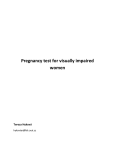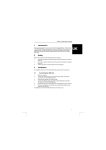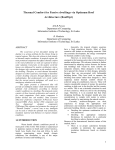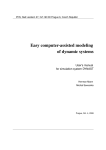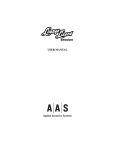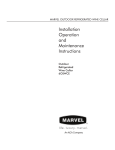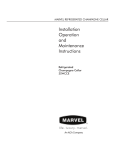Download Pregnancy test for visually impaired women Tereza Hyková
Transcript
Pregnancy test for visually impaired women Tereza Hyková [email protected] Task description The goal of this project is to find a solution that will enable visually impaired women to interpret the result of a pregnancy test in privacy and without the help of another person. The output should be a user interface for an application, which accepts an image of taken pregnancy test and reports its result. The suggested solutions are either the use of a scanner and a PC application, or the use of a camera integrated in a mobile phone and a mobile application. We will try to describe the advantages and disadvantages of both solutions and choose one, eventually find other possible options. Target group The target group are girls and women that are incapable of interpreting the result of a pregnancy test on their own due to their visual impairment. Screener The following screener is designed to be given only to visually impaired persons. 1. 2. 3. 4. Gender? (male, female) Age? (<17, 17-30, >30) Are you blind since your birth? (yes, no) Have you got any experience with pregnancy tests? (personal experience, friends‘ experience, no experience, other) Targets: 1. 2. 3. 4. 90% female, 10% male 50% 17-30 yrs., 50% 31 yrs. and more 50% yes, 50% no 80% personal or friends, 20% no experience Notes: 1. The target group are women, but we can include men in the user research as well thanks to their experience with controlling technical devices, which is not gender dependent. 2. We are trying to gather information both from adult women and young girls who are more expected to have the lack of privacy problem. 3. We assume (and need to prove this assumption) that the ability to control a camera is highly influenced by the fact, whether the person is blind since the birth or not. 4. Most information about specific problems with pregnancy tests will most likely be given by people, who already have some experience with them. Even people, whose acquaintances already encountered this problem, are expected to have some insight. However we also need to know if there are any essential reasons why some people have no experience at all (for example they might not even be aware of the existence of pregnancy tests). User research (interview) Preparation 1. Pregnancy test in general a. How have you been solving this problem so far? b. Do you think a new solution would be useful? c. What experience with pregnancy tests have you got? d. Would you trust a technical device to let it interpret the test for you? 2. Experience with pregnancy test a. What type of test did you use? b. How did you find out how to use it? c. What did you use to countdown the time? d. How did you interpret the result? 3. Scanner and PC a. Do you own or have you got an access to these devices? b. Are you comfortable with using these devices? If not, why? c. How do you control PC, how do the PC programs communicate with you? d. What do you think in general about the option of scanning the taken test? 4. Mobile device with integrated camera a. Do you own a mobile device with a camera? b. What type of mobile phone have you got, are you capable of installing new mobile applications? c. Do you use the camera? If not, why? d. How do you control your mobile phone, how does it communicate with you? e. What do you think in general about the option of using a camera and mobile application to interpret the test? Interviews summary Interviewee A: The first interviewee is a woman in her forties. She has not used a pregnancy test her whole life until recently, when she was provided with one at the doctor’s. She believes that many blind women and girls are not even aware of their existence and deal with the consequences when it is already late. She also thinks that there is currently no solution for visually impaired people available – the only option is to visit a doctor or get a help from acquaintances who can see. Interviewee A did some personal research and found out that the manuals how to use the specific tests are available on the internet. She would however be glad to have it as a part of the application database, including the countdown timer. She does not directly refuse the option of sending the image to a person who can see to ask for the interpretation, but does not trust the provided anonymity. Interviewee A is very comfortable with using of a scanner and a laptop with a reading program. She controls the laptop using keyboard only. These devices are very common to her and she believes that it is an essential equipment of every visually impaired person. She does not think that scanner is capable of resolution high enough to be able to interpret a small test stripe. She also fears that the scanner will get dirty when scanning the test. A mobile phone is very common equipment to her as well – she uses a completely ordinary phone with a Mobile speak software installed. However, she does not use the integrated camera at all (and it is the same with all the other visually impaired people) because she is not capable of targeting a specific object. It seems that she can hardly imagine the capabilities of a camera or guess even an approximate composition of the taken image. She is willing to try to use it for this purpose though. The combination of a camera in a mobile phone and a mobile application would be much preferred by interviewee A. The main reasons are the good portability of a phone and already stated distrust in scanner’s capabilities. Interviewee B Interviewee B is a middle aged man who has no experience with pregnancy test from a blind person’s view. However, he believes that a special solution would be very useful. He is highly skilled in controlling both mobile phone and PC with scanner; he even visited a special course where visually impaired people are taught these abilities. But he refuses to give any advices himself and leaves this matter exclusively to the experts in this field. He considers these devices as an absolute must for all blind people. Both devices communicate with him using reading software; he controls the mobile phone as an every other phone and laptop solely with keyboard. Interviewee B absolutely refuses using a camera and considers it as a completely useless device for blind people. On the other hand he highly supports the use of scanner and PC, mainly because of the fact that they are so widely available and used among the target group. He states that it is much simpler to put something on a scanner desk than target a desired object with a camera. Interviewee C The third interviewee is a middle aged woman. She has a husband and a son, both of whom can see, she however feels that she and all the other women would welcome the chance to be capable of interpreting the pregnancy test on their own. So far she has been dealing with the problem using a help of another person and claims it is the only option. She does not know what types of tests there are and how they are interpreted because she never actually needed to know. She finds the countdown timer a useless tool because she will use her mobile phone for that anyway, but a small database of tests manuals seems like a good idea to her. The idea of sending the image anonymously for interpretation to another person seems rather ridiculous to her. She claims that the community is too small to keep it anonymous and thinks some women who are trying to get pregnant and use the test often would be embarrassed. Interviewee C owns a PC and a scanner, knows how to use them, but does not actually use them much anymore - she has no need for it since e-books became widely available. She has a hard time understanding what the output of a scanner might be and thinks it is directly a text that can be read by screen reader. To control a PC she uses a keyboard and a screen reader or Braille display. She thinks that not all visually impaired people should be expected to own these devices though, because they are allowed to ask for them only once per 5 years. Especially young girls might not have need for them at first and then need to wait a long time before they can ask another time. She uses a mobile phone often, but does not use the integrated camera. She tried a few times but never managed to target what she wanted. She claims that some blind people use it, but they only make abstract photographs and need other person to describe what is in it. Therefore she does not think the option of taking a picture of a taken test is a good idea. Knowledge gained summary: A pregnancy test for visually impaired women would be a very welcome tool, because there is no solution for this problem at all yet. We did not find any unexpected problems in the user research that would not be obvious from the task description – we can stay focused on an application for getting the interpretation of visual information. The manipulation with the given technical devices is a very common thing to most of the visually impaired people except for the camera. All of the interviewees agree that they do not and probably will not use it, mainly because of their inability to target a desired object and choose an appropriate distance. All the interviewees control the mobile phone and PC by keys and have reading software installed. Some use a Braille display. No other options than scanning or taking a picture with a camera was suggested by any of the interviewees and they mostly rather stick to the scanning. The idea of sending an anonymous image for interpretation was either completely refused or accepted but it will probably be not used anyway. Requirements and recommendations All the interviewees require only the basic functionality, i.e. a simple program that will interpret the test result for them – whether it is positive or negative. They do not refuse the other functions such as countdown timer or most common tests database and their manuals, but they hardly require them. From the suggested options we will stick to the use of a scanner rather than a camera because of the technical limitations. The picture taken by visually impaired people will probably not have a quality good enough for a machine processing and therefore the application would not provide a reliable interpretation. Also, the option of sending the image anonymously for interpretation is inacceptable for various reasons given above. Use cases and scenarios: Since our application is focused on a single main task with just a few bonus features, the use cases and scenarios are rather brief and simple. 1. Browse the tests database Find what types of tests the application supports: Before the user wants to take a pregnancy test, she needs to know what types of tests the application supports. To do this, she opens the application database and loops through available test names. Find a user manual for a desired type of test: Once the user purchases a specific test, she needs to know how to use it. She opens the application database, selects the type she wants and has the detail open. Detail shows all the information needed for performing the test correctly. 2. Countdown timer Let the application countdown desired amount of time: Once the test is taken, it is common that the user needs to wait a specific number of minutes before she can see the correct result. It is also common that the results should not be interpreted after a given number of minutes. i. The user selects the countdown time option, chooses the number of minutes for the first and optionally the number of minutes for the second alarm. Once the alarm rings, she can stop it. ii. Another option to use the countdown time feature is to start it right from a test detail screen. In this case, the numbers of minutes is automatically set according to the user manual in the database. 3. Interpret a test Open a scanned test in the application: The user scans the test in another scanning program she is used to and saves it as an image. Then, in our application, she selects the option to open a file and chooses this image. The application will report whether the image was successfully open. Scan an image right inside the application: The user selects the option to scan an image. The settings will be automatically set to common values with highest resolution possible. The user puts the test in the scanner and selects the start scanning option. The application will report whether the image was successfully scanned. Define used test type: The user needs to define the type of test she used, so that the application knows how to interpret the image data. She selects it from the database the way already described. Interpret a test: With image and test type defined, the user can order the interpretation to start. If the processing is successful, the application announces the result of the test (positive or negative) and the probability of correct answer (for example in the first month of pregnancy, only a very light stripe can be seen, which indicates a positive result). If it is unsuccessful, an error and its cause are reported. This can happen for example if the defined test type is not found in the image or if the check indicator (e. g. stripe that should always appear when taking the test) does not appear. HTA and plans: Plan 1 – Find a test in the database: do 1.1, then 1.2, then 1.3 Plan 2 – Countdown specified amount of time do 2.1, then 2.2, after the time expires do 2.3 Plan 1, then 2.2, after the time expires do 2.3 Plan 3 – Get test result Do 3.1 i. either 3.2.1.1, then 3.2.1.2, then 3.2.1.3 ii. or 3.2.2.1 then 3.2.2.2 then 3.2.2.3 Do 3.2 – Plan 1 (3.1 and 3.2 can be done in any order) Then 3.3, then 3.4.









